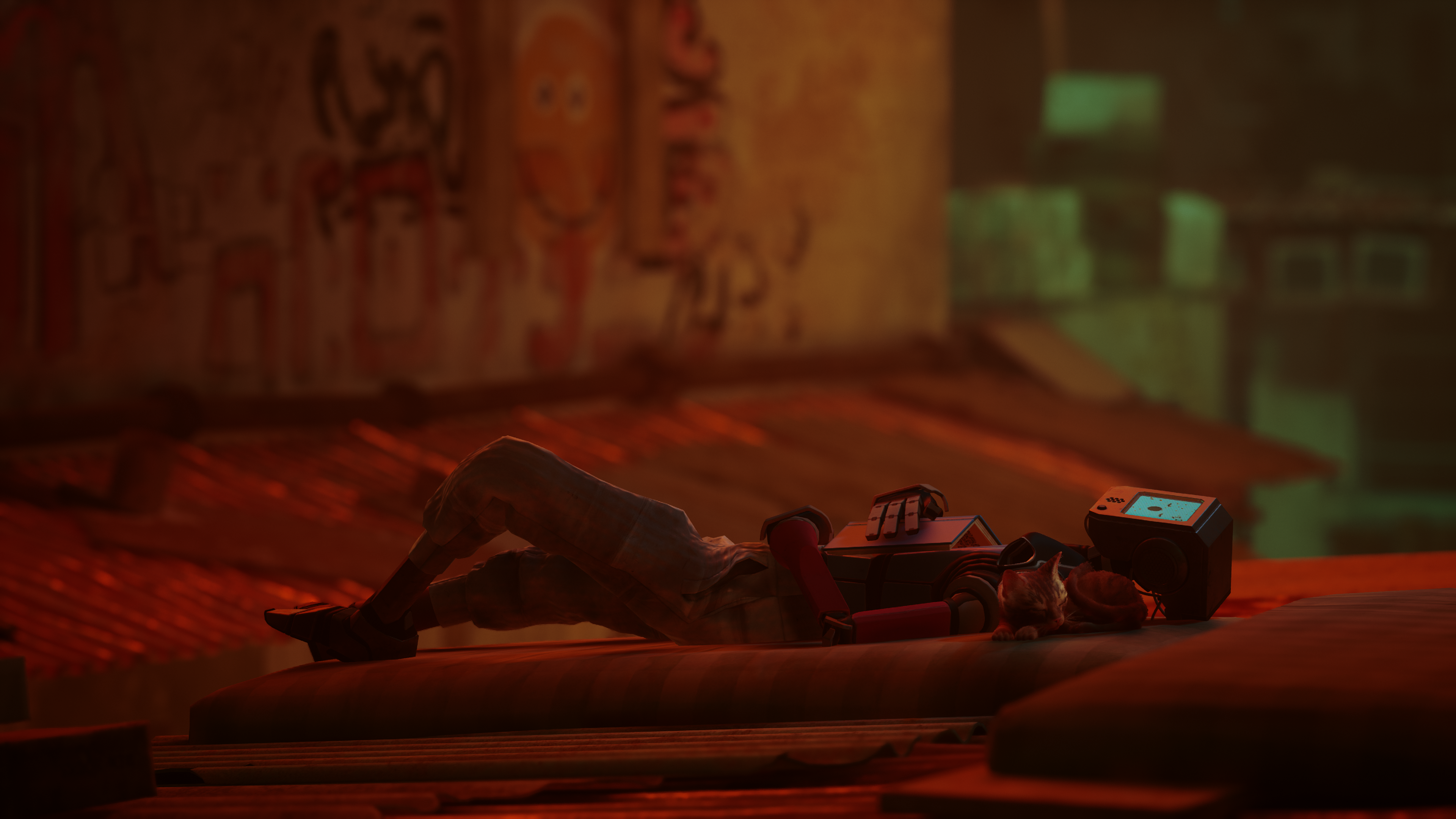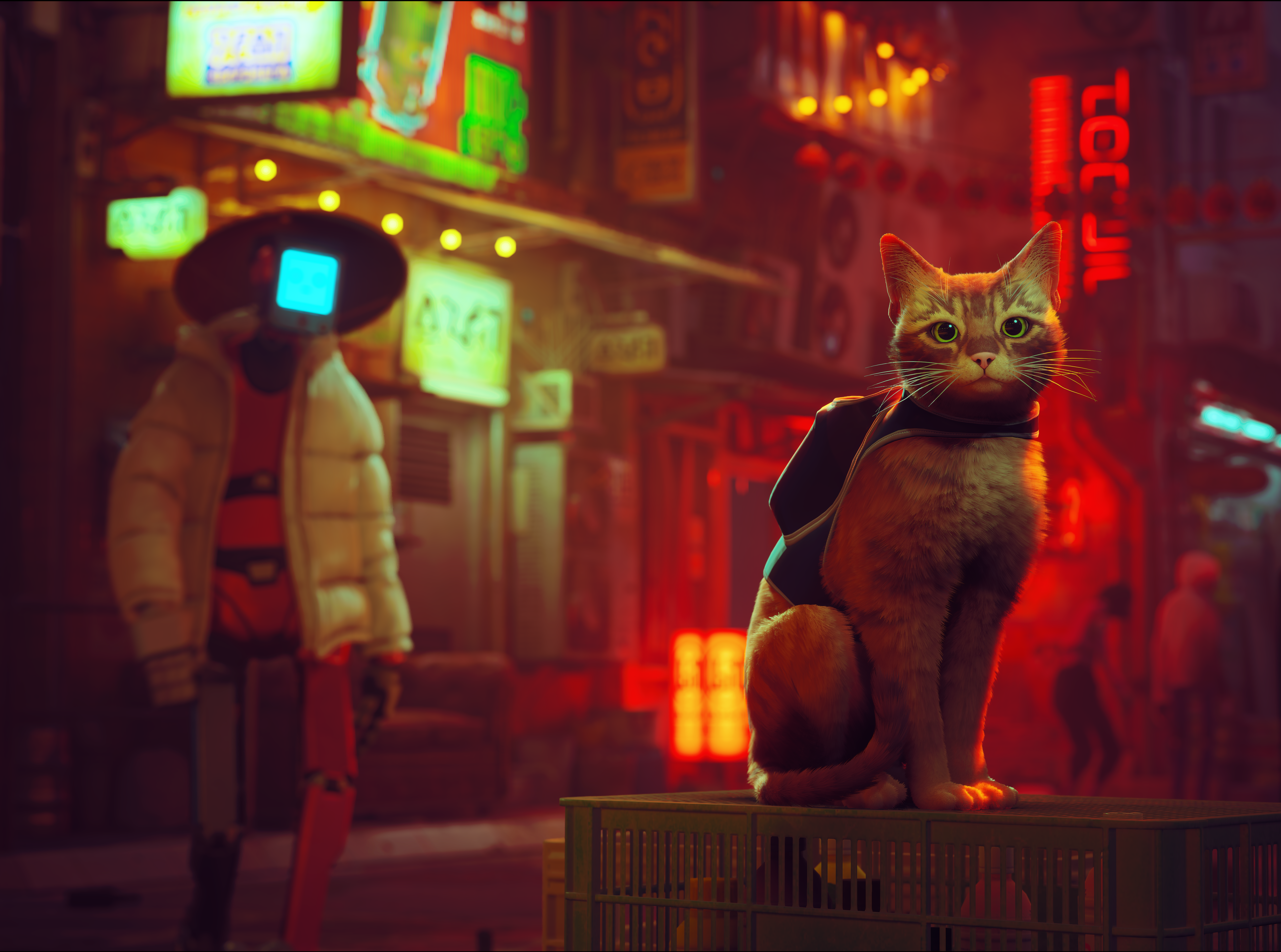Products You May Like
From the outside, Stray is an adventure game made for lovers of cats and science fiction. However, at its core, Stray is something much more than that; it’s a testament to curiosity and exploration, and really hones in on how cats can seemingly make any place a home.
As my hands-off preview begins, I find it hard to contain my excitement. I watch the silhouette of our furry protagonist simply doing ‘cat things’ while in their idle animation. Producer, Swann Martin-Raget, walks us through the game and explains what we can expect from the adventure, deftly avoiding giving away any plot details.
Stray’s setting is the “perfect playground” for a cat
He starts us by walking the furry, ginger cat through the streets of Midtown; the setting is dark and dreary – yet outstandingly beautiful. Martin-Raget explains that the environment is directly influenced by Kowloon Walled City, with the inspiration for a feline protagonist coming from developer conversations around how Kowloon would be the “perfect playground” for a cat. After seeing the four-legged friend roam around Midtown and its various platforms, I have to agree.
As our protagonist pitter-patters through puddles, a faint trail of paw prints is left behind, and Martin-Raget explains “at it’s core, really, Stray is an adventure game. It has parts of puzzle-solving quests, as well as action, but the main part [of Stray] is its story.” A story which Martin-Raget was very reluctant to tell us about, and I’m thankful for that. BlueTwelve Studio’s first game is clearly intended for curious minds, and what fun is there in spoiling the adventure?
“[Stray] tells the story of this cat that has fallen inside a very mysterious and dangerous city at the beginning of the game. He is separated from his friends and his family, and his goal is to try and understand the rules of this new environment and its inhabitants, as well as try to escape the city,” Martin-Raget explains. It all starts out very solemn; our cat character creeps gingerly around the area, tentatively exploring this strange new world.
.png/BROK/resize/690%3E/format/jpg/quality/70/Stray4-(1).png)
“Much of the storytelling is done through cinematics and dialogue, but environmentalised storytelling is also very important to us,” says Martin-Raget. And this shows. Our sheepish protagonist soon springs to life and picks up the pace, running past various neon signs, toppled paint cans, and intricate environmental details to an area of Midtown that is much more vibrant.

You might’ve noticed me clawing for adjectives and descriptors for our protagonist; that’s because if our cat has a name, we don’t know it yet. However, we do know that the cat is based off Murtaugh, one of the cats belonging to the studio’s founders. So, while Stray feels about as far from Lethal Weapon as you can get, I’m referring to our protagonist as Murtaugh from here on out.
“[There are] contrasts we’re trying to have in the game,” Martin-Raget shares later on in the demonstration. “It was really a driving direction for us. For instance, you can see the contrast between the cat being small, organic, and lively, and the robots that are a bit more angular and bold.” Contrast in a game like Stray makes perfect sense; the cat has landed in a weird, unknown environment that is very different from everything they know and love. In a sense, Murtaugh may be the only living, breathing creature in Midtown.
At the end of the day, the protagonist in Stray is lost and alone, so, having an environment that feels disorienting and serious – offset with “almost comical” droids – provides what I will happily call the perfect setting for such an adventure. But will this out-of-place narrative last the whole game? I’m of the firm belief that this curious little cat could make any place a home – even Midtown – but we’ll see.
Everything appears to have been crafted with the upmost care for the team, their cats, and the players

As well as a clear focus on narrative and environments, the team at BlueTwelve Studios have not neglected the fact that their main character is a cat, either. While the team didn’t use motion-capture, they have had one developer working tirelessly on the development of this cute creature, using reference material from online and, of course, from the office cats. Fortunately, as Martin-Raget points out, it appears the internet was made for sharing cat content; and don’t worry, he also explained that the office cats (who are seen as the bosses of the studio) are well looked-after too.
As Martin-Raget moves Murtaugh into the next area, we get our first look at the platforming. We all know exactly how agile cats can be, so platforming in the traditional sense didn’t feel fitting; cats don’t fail precarious jumps repeatedly like a human would, and then there’s the age-old tale about cats always landing on their feet. “The movement around the environment was something very important to us,” Martin-Raget continues. “A classic platforming challenge really didn’t feel like being a cat, so we went for another compromise that really allows players to feel this agility and the rapid movements.”

What was perhaps even more interesting is how employing a feline protagonist has allowed for “a lot of interesting new level design that wouldn’t be possible with a human,” and this appears to include a focus on verticality. Platforming in Stray feels fresh, and almost effortless, but you can see that there’s room for error – even cats can misjudge a jump sometimes!
Staying faithful to Murtaugh and feline movement, it seemed only right that the team employed other cat traits, too. You can push cans from ledges to your heart’s content, meow whenever you please, and even curl up with some of Midtown’s robot residents. These are more than just aesthetic elements, too, as some of these actions are required Stray’s puzzles, and to aid in basic exploration. Martin-Raget demonstrates a handful of these puzzles to us while avoiding any plot spoilers; we can see the ‘FOLLOW ME’ signs beckoning Murtaugh, but alas, Martin-Raget shows us Murtaugh drinking from his water bowl before squeezing themselves under a door (in true cat fashion) before showing us the next puzzle.
BlueTwelve clearly wants its game to be as pristine of an experience as possible

Throughout the demonstration, gameplay is smooth, there’s no lag, bugs are nowhere to be seen. We’re a bit further in, now, and Murtaugh has his robotic backpack. The backpack, named B-12, is used to help Murtaugh communicate with other characters, remind him of what his goals are, and of course, to act as a flashlight whenever it gets dark. The backpack also has a small inventory so that Murtaugh can loot items throughout their adventure; what items exactly we aren’t yet sure, but I certainly hope I can bring the robot residents ‘gifts’. Cat owners, you know what I’m talking about…
Speaking of robotic residents, Martin-Raget explains that “each character has a very unique personality and background story.” It’ll be up to players to get to know the characters and “maybe help them”, and we can only assume that Murtaugh will no doubt be learning from them, too. Ultimately, how else is he going to escape if not with some help from the weird world’s inhabitants?

As Murtaugh breezes past some droids, he curls up for a nap beside one of them: “[sleeping] is the majority of a cat’s schedule,” says Martin-Raget, and he’s not wrong. Murtaugh gets back up again with an elegant stretch, before then finding a TV remote to play with and a sofa to scratch. Martin-Raget notes that the scratching provides haptic feedback for DualSense controllers, and he shares that they’ve tried to utilise the feedback where possible in the game.
In some instances, holding the DualSense controller can feel like you’re holding a tiny cat, with Murtaugh’s purrs coming through the controller. This is another small touch that Stray can add to its long list of careful details; details which will undoubtedly make Stray stand out from other indie games this year. It’s nice to see a studio putting some more of the DualSense’s more esoteric aspects to good use.
Stray is rewarding to the most curious of players
Overall, it feels like BlueTwelve’s development of Stray is an anecdote for Stray’s gameplay itself: the studio appears to have explored just about every avenue when it comes to crafting an adventure game with a cat for the protagonist, and have created a game that rewards the most curious and adventurous of players. The finished project, I’d hope, is a huge reward for BlueTwelve and their adventurousness when it comes to actually putting such a charming idea in motion.

You can feel the level of commitment and passion that have gone into this game; from Murtaugh’s movement and the detailed environments, to crafty level design and a pseudo-third person camera for taking in your surroundings, it really feels like the developers have thought of just about everything – from a cat’s-eye view – to try and make Stray a near-perfect, and incredibly touching, feline adventure.
If there’s any one single thing that I took away from my time, it’s that an amazing amount of love, care, and dedication has gone into trying to make this game a proper homage to cats, and cat lovers, everywhere. Stray is to last nine to 10 hours for the most adventurous of players, and will release later in 2022. Here’s hoping the fantasy of being a cat in a neon-drenched world won’t outstay its welcome, then. From what I’ve seen so far, I don’ think that’ll be an issue.
In the meantime, I’m going to be tearing up at how cute all the in-game screenshots are.
